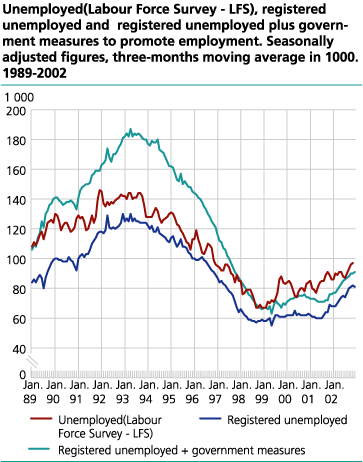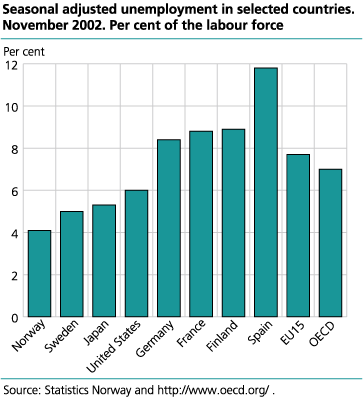Content
Published:
This is an archived release.
Unemployment went up
The numbers of unemployed persons increased from the third to the fourth quarter of 2002. Man-weeks worked have shown a decreasing trend since autumn of 1999. The numbers are adjusted for seasonal variations.
Norwegian unemployment has shown a weak increase since the autumn of 1999 according to seasonally adjusted figures from the LFS. From the 3-months period July - September to October - December 2002 total unemployment increased by 7 000 persons. In per cent of the labour force the number of unemployed persons increased by 0.3 percentage points, which is outside the error margins. Seasonally adjusted figures of registered unemployed persons at the Employment Offices the last year also indicate an increasing unemployment.
The employment has shown only a slight increase from 1999 and onwards, after a period of strong growths. Through 2002 the numbers of employed persons have been just about unchanged. From the third to the fourth quarter2002 the numbers of employed persons decreased by 3 000, which is within the error margins.
Man-weeks worked decreased
Man-weeks worked have shown a decreasing trend since autumn of 1999. It looks like the latest figures support the trend, however the decrease in man-weeks worked of 5 000 from the third to the fourth quarter last year is within the error margins.
Unemployment increased in the EU and the OECD
The seasonally adjusted unemployment rate in Norway increased from 3.8 per cent in August 2002 to 4.1 per cent in November. In the same period the unemployment increased from 7.6 to 7.7 per cent as an average in the EU member countries. The unemployment rate in the OECD-countries as a whole increased from 6.9 to 7.0 per cent. In November 2002 the unemployment rate amounted to 6.0 in USA, 0.3 percentage point higher than in August. The unemployment rate in Sweden also increased by 0.3 percentage point to 5.0 per cent. In Finland the unemployment rate decreased from 9.2 to 8.9 per cent. This is according to figures from OECD .
About the man-weeks estimates
From the first quarter 1996 the LFS-data were collected weekly, compared to earlier when only one ordinary week pr. month was selected. For the time being, the break in the series is handled by making monthly estimates where weeks with especially high absence rates are kept out of the estimation. Due to the Christmas holidays the interviews from the last week in December 2002 were kept out of the estimation of man-weeks worked, like in 2001. In addition the holiday absence rates are set equal to the corresponding absence rates in the reference year 1991 in order to get comparable time series.
After seasonal adjustment, the levels are corrected to make the annual averages of the seasonally adjusted figures equal to the corresponding unadjusted figures from the LFS. In this release new factors of level correction are used, because the annual averages for 2002 of unadjusted LFS are first ready by this release. Due to preliminary factors of level correction in earlier releases in 2002, these seasonally adjusted figures of 2002 may deviate from the figures in this release.
Uncertainty
Quality tests show that the seasonally adjusted LFS unemployment figures are uncertain. The seasonal-adjustment method has problems identifying a stable seasonal pattern for this series. The random component is relatively large compared to the seasonal component. In addition there are only a few unemployed persons, which may result in the uncertainty being considerable. The figures should therefore be used with caution.
The purpose of adjusting for seasonal variations is to describe the development during the last year and to give figures for change between the last two 3-month periods, cleared for normal seasonal variations. In order to reduce uncertainty, the presented series are three months moving averages of the seasonally adjusted figures. For instance the figure from November is the average of the estimates from October, November and December.
Tables:
The statistics is published with Labour force survey.
Contact
-
Arbeidsmarked og lønn
E-mail: arbeidsmarked@ssb.no
-
Erik Herstad Horgen
E-mail: erik.horgen@ssb.no
tel.: (+47) 93 08 68 62



